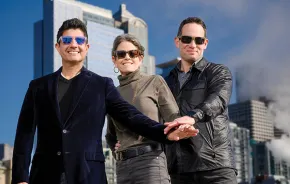
Editor’s note: In this nine-month series we explore how new voluntary standards developed in Washington state are impacting the quality of after-school programs that serve about 134,000 youths after the school bell rings. We will explain what parents should seek in a program, look at research on the impacts of quality care on kids’ development and academics and visit with programs that are successfully serving kids and helping families. After-school Special’s independently reported content is funded by a journalism grant in partnership with the Raikes Foundation and School’s Out Washington. See the full series of articles here.
To the Cotton Club strains of Duke Ellington’s "The Mooche," Megan Adams leads middle schoolers in a jazz routine. Trumpets, clarinets and other instruments breathe life into “zoo animals” — the choreography transforming kids into heavy elephants, hippos and lithe gazelles. “Picture this as you are swinging your hips or moving your arms: What are the animals doing after the zookeeper goes home?” asks the Village Theatre instructor, challenging the kids to imagine as they practice chassé and pas de bourrée steps in sequence.
Upstairs at Village Theatre’s First Stage in Issaquah, young singers warm up their vocal chords before practicing "Blue Suede Shoes" from the musical All Shook Up. Earlier this afternoon, these KidStage students had two hours of acting instruction. But here, the tweens and teens aren’t just being told what to do: They are learning through a process of guided discovery, where they take turns coming up with creative ideas, leading exercises, even creating and producing their own musical.
“Theater is, by its nature, an art form that depends on collaboration,” says Kati Nickerson, the theater’s director of youth education. “You need all different kinds of people, different disciplines, while the stories themselves build kids’ ability to empathize. It calls for emotional intelligence.”
Garrett Steffen, 14, of Issaquah, jokes with his mom that he would live at Village Theatre if he could. “The kids here are encouraged in a safe space, this family-like group,” his mom, Kristina Steffen, says. The benefits of this program have reached beyond the teen’s time at the theater, his moms adds. “He has developed a level of self-confidence that’s helped in school, an ability to get up in front of a crowd and put himself out there in a way that classmates may not want to do.”
The theater hires more than 150 different educators each year between its Issaquah and Everett locations, and that number could grow. Between 2010 and 2014, the Issaquah location increased enrollment from 1,350 to 1,800 students. It may be no coincidence that starting in 2013, the organization embraced a set of voluntary youth program quality (known as YPQ) standards put forth by School’s Out Washington with the goal of helping programs and staff do what they do better.
Like a theatrical production itself, the YPQ standards cover a range of categories across nine domains, ensuring, for example, that each program enriches the physical, social, emotional and creative development of all the participants. These domains outline what it takes for an extracurricular program to be of the highest quality, and they provide a framework for even top-notch organizations to raise their bars even higher.
“It’s about giving kids with all different learning styles different ways to engage."
-Suzie Bixler, KidStage Program Manager
What do these standards, and the fact that some programs are adapting them, mean for the student experience, and for how the programs, which parents pay for, are run? One example, according to KidStage program manager Suzie Bixler, is the dedicated time for youth reflection — a deliberate effort to have students think about and share what they have learned that day. Or maybe on another day, they don’t share out loud, but instead write down three things they want to work on. “It’s about giving kids with all different learning styles different ways to engage,” Bixler says. “And this coming year, we will work even more with kids on how to give and receive feedback.”
By asking whether extracurricular programs are following the YPQ standards — and by asking questions about how staff empowers young students and incorporates their ideas, for example — parents can better assess what kind of positive impact programming will have on their young children, teens and tweens.
Shannon Nelson drives her 13-year-old daughter, Claire, from Carnation each week to her theater classes. Claire will be a tap-dancing Tin Man in the Village Theatre Institute’s The Wizard of Oz in May. A girl who was already comfortable in her own skin, Claire has developed positive traits in this program that have caught the notice of her middle-school classroom teachers. “She is very supportive of other people,” says Nelson. “Rather than tearing people down, she builds them up.”
Being rooted in creativity, arts programs would seem to naturally excel at youth empowerment — one measurable trait of a high-quality program. But as dance instructor Adams points out, “Music and dance are often a top-down lesson plan.” Adams would know. As an 8-year-old, she sang her way into the starring role in Village Theatre’s Mainstage production of Annie. She has been teaching kids for 25 years.
With her own talent and experience, Adams could relentlessly seek conformity and perfection. However, she understands that top-notch dance numbers cannot come at the expense of “youth voice.” Students must be allowed to help shape their work, she says. “The product may not be perfect, but who cares? What we care about is that they care about their product.”











